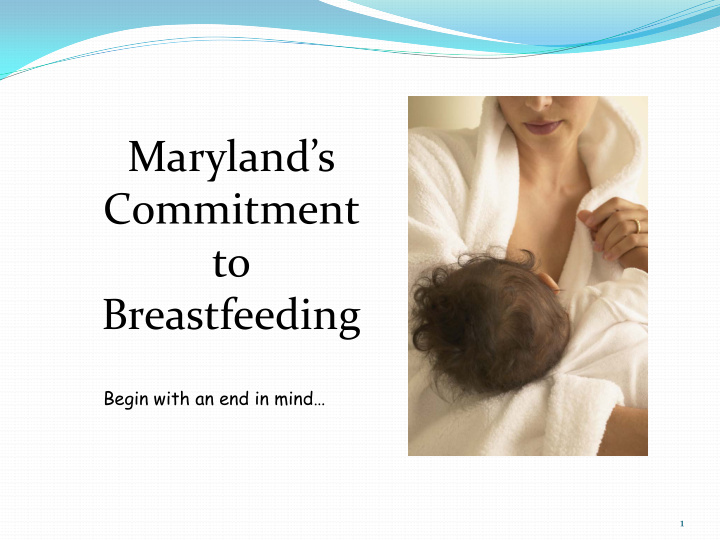



Maryland’s Commitment to Breastfeeding Begin with an end in mind… 1
Breastfeeding is a public health priority: “Given the documented short and long-term medical and neurodevelopmental advantages of breastfeeding, infant nutrition should be considered a public health issue and not only a lifestyle choice.” – American Academy of Pediatrics, 2012 “For nearly all babies, breastfeeding is the best source of infant nutrition and Immunologic protection…” (Regina Benjamin, U.S. Surgeon General) 2
Obesity is Child care, associated with school, worksite, Physical activity ? health care many environments factors….some known, some Economic Breastfeeding Factors unknown Breastfeeding helps Education Genetics protect against childhood Marketing obesity. A baby's risk of becoming Built Healthy food access Environment an overweight child goes ? down with each month Pricing strategies of breastfeeding. 3
Childhood obesity is an epidemic. In the US, 1 preschooler in 5 is at least overweight, and half of these are obese. 4
Obesity and overweight in Maryland, 2010 • 32% of low-income Prevalence of Obesity* among Children children ages 2-4 are aged 2-4 Years, by County, 2010 overweight or obese • 28% of high school youth report being overweight or obese • 66% of Maryland adults report being overweight or obese 5
How might breastfeeding protect against overweight? • Breastfeeding mothers may choose a healthier lifestyle, including diet and exercise. • Endocrine response in formula-fed infants may result in higher insulin levels leading to increased deposition of fat tissue. • Infants fed at the breast control the amount of milk they consume – learn to better recognize hunger and satiety cues • More research is needed…. Data source: Research to Practice Series, No. 4, July 2007, National Center for Chronic Disease Prevention and Health Promotion, CDC 6
A snapshot of breastfeeding in Maryland 7
Maryland’s Breastfeeding Report Card, 2011 Healthy People 2020 Breastfeeding 2011 CDC Breastfeeding Report Card Categories of Infant Feeding Objectives Maryland Rates Ever Breastfed 81.9% 78.5% Breastfed at 6 months 60.6% 45.2% Breastfed at 1 year 34.1% 27.0% Exclusively breastfed at 3 months 46.2% 32.0% Exclusively breastfed at 6 months 25.5% 13.1% Reduced percent of breastfed newborns receiving formula supplementation in 14.2% 30.9% first two days of life (goal) http://www.cdc.gov/breastfeeding/pdf/2011breastfeedingreportcard.pdf http://www.usbreastfeeding.org 8
Maryland PRAMS Report: 2010 Births 9
Characteristics of the 19% of Mothers Who Reported Never Breastfeeding, Maryland, 2010 34 30 26 24 23 19 12 12 11 11 11 Years of Age Race/ethnicity education* *Includes only mothers ages 20 and above. Note: Percentages are not reported if the number of respondents was less than five. Data Source: Maryland PRAMS 10
• Mothers and families • Communities • Health care providers and facilities • Employers • Public health leadership • Researchers 11
Maryland’s First Steps 12
2010 Legislation • Maryland License to Breastfeed • Maryland was the first state to allow tax exemption for supplies that may be used by nursing mothers. 13
Programming: WIC Breastfeeding Support • Established breastfeeding coordinators at the state and local levels • Loving Support Peer Counseling Program established in 2004 • Employs 20 International Board Certified Lactation Consultants. • WIC breastfeeding incidence rates in Maryland: • April 1995 – 32.6% • April 2004 – 51.5% • April 2012 - 63.9% 14
Collaboration with Maryland State Department of Education for breastfeeding support in child care settings • Implement infant feeding standards • Allow infant to stop feeding on cue • Hold infants while bottle feeding • Introduce age appropriate solid foods • Serve breast milk to at least 12 months • Professional Development and Training • Preparing, feeding, storing human milk • Ensure on-site accommodations • Designated place for breastfeeding Source: “Preventing Childhood Obesity in Early Care and Education Programs” • http://nrckids.org/CFOC3/PDFVersion/preventing_obesity.pdf • 15
Promoting breastfeeding resources to employers • Healthiest Maryland Businesses Website • Worksite wellness training events and forums http://dhmh.maryland.gov/healthiest/SitePages/Home.aspx 16
Maryland State Workplace Wellness Campaign Goal: Develop a supportive environment for breastfeeding. Action: The state will establish a model support for breastfeeding policy and track the number of state worksites that adopt it. 17
Nearly all births in the United States occur in hospital settings… 18
More breastfeeding support in Maryland birthing facilities is needed “ Improvement is needed in maternity care practices and policies in Maryland.” “Many opportunities exist to protect, promote, and support breastfeeding mothers and infants in Maryland.” Maternity Practices in Infant Nutrition and Care In Maryland —2009 mPINC Survey 19
Maryland Hospital Breastfeeding Policy Recommendations 20
Development of a Model Breastfeeding Policy: A Collaborative Process August 2011: DHMH workgroup formed and reviewed hospital policies in Maryland and other states December 2011: Stakeholder’s meeting held January 2012: Draft recommendations created February 2012: Draft recommendations posted on the DHMH website for public comment • Over 130 comments were received and evaluated • Subsequent draft policy created Next steps: Second draft of breastfeeding policy recommendations will be posted again for comment and review. 21
Thank you. 22
Recommend
More recommend